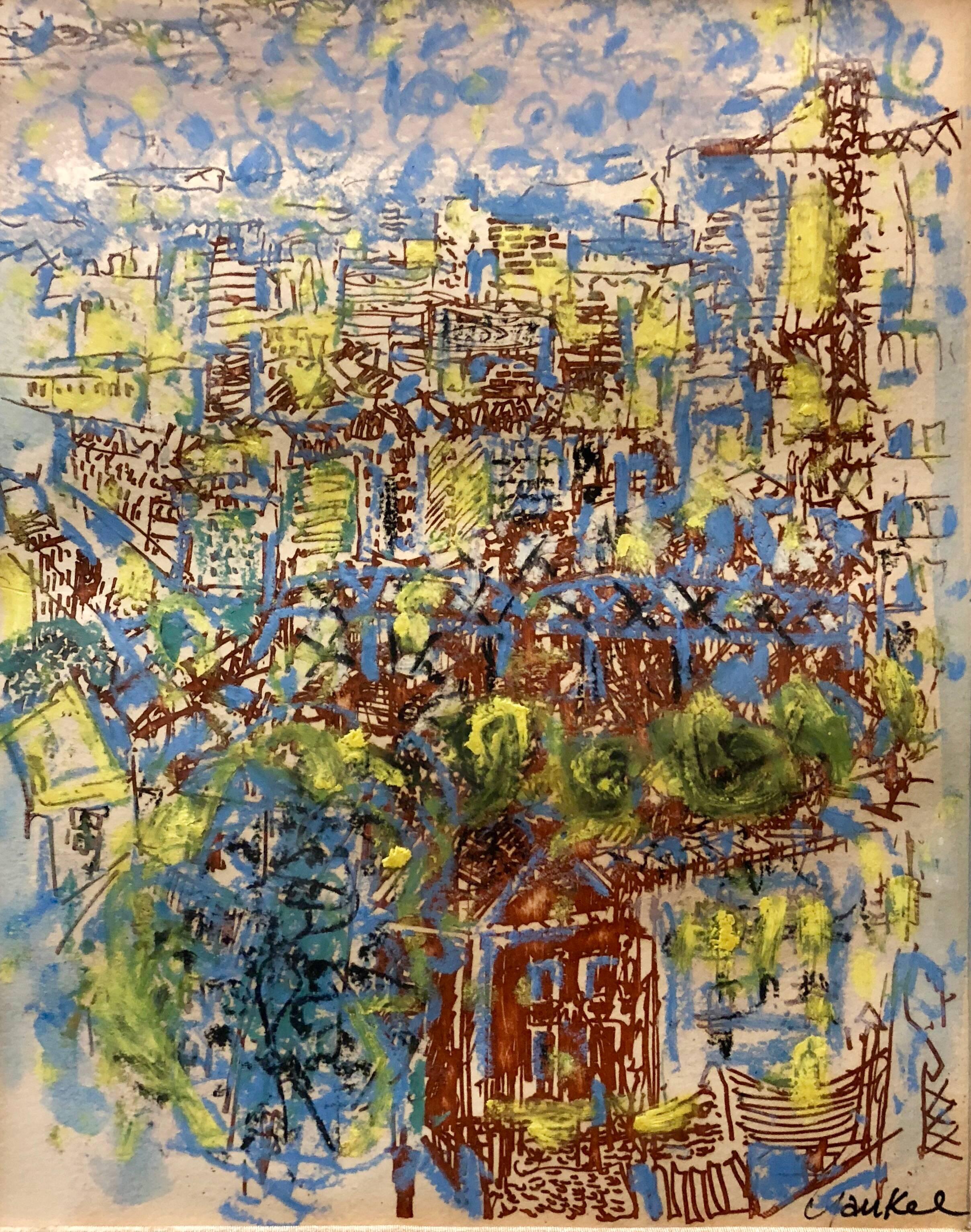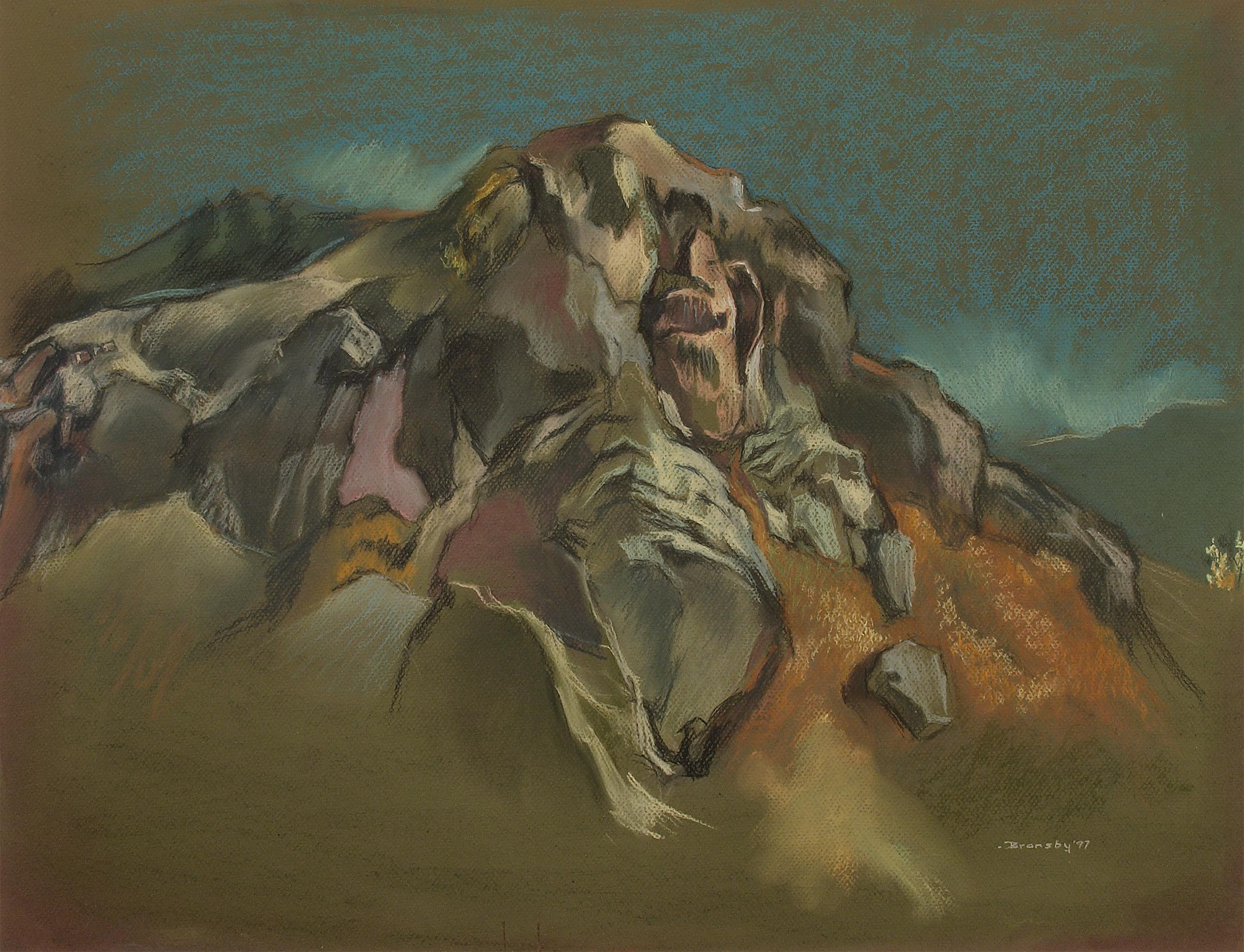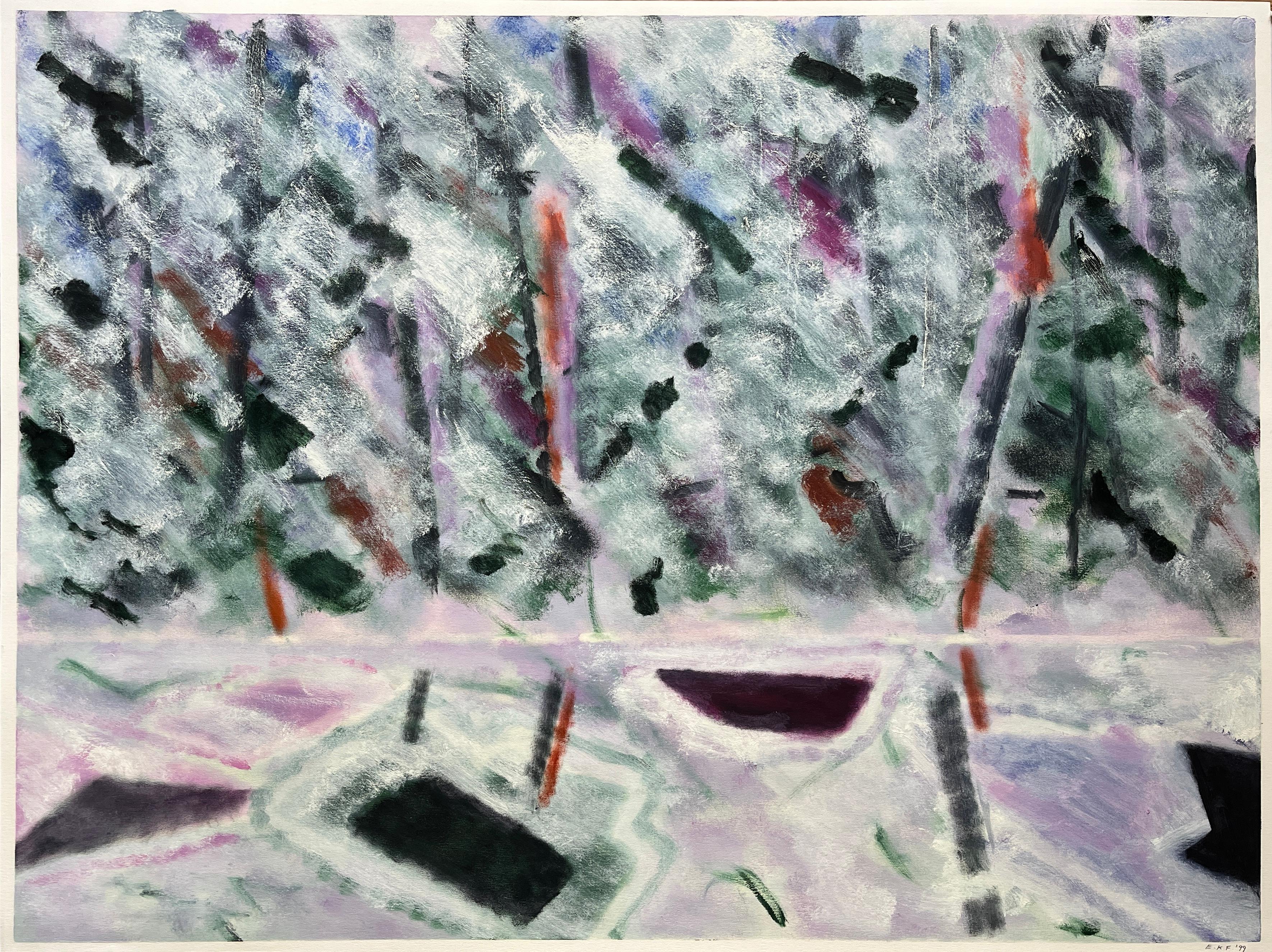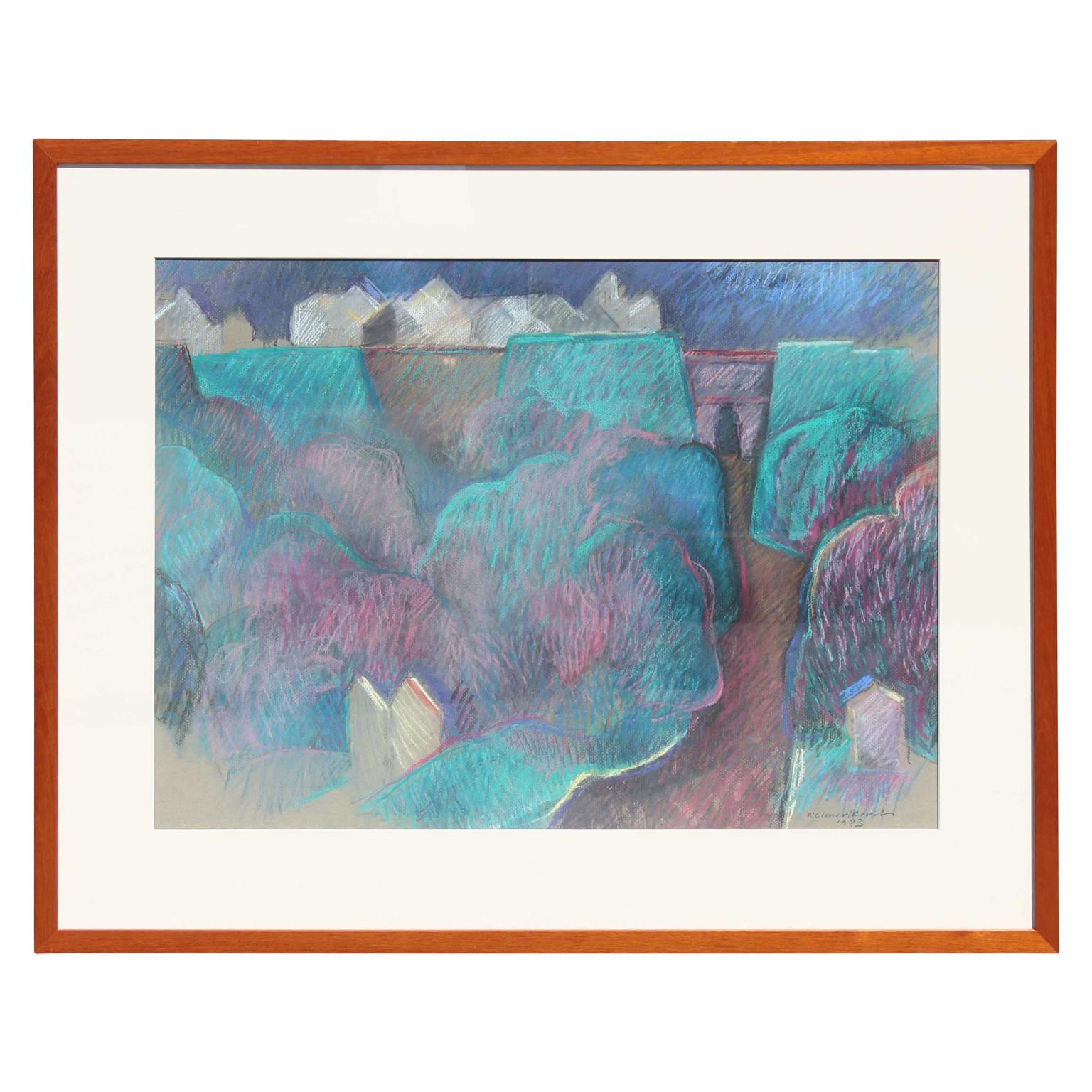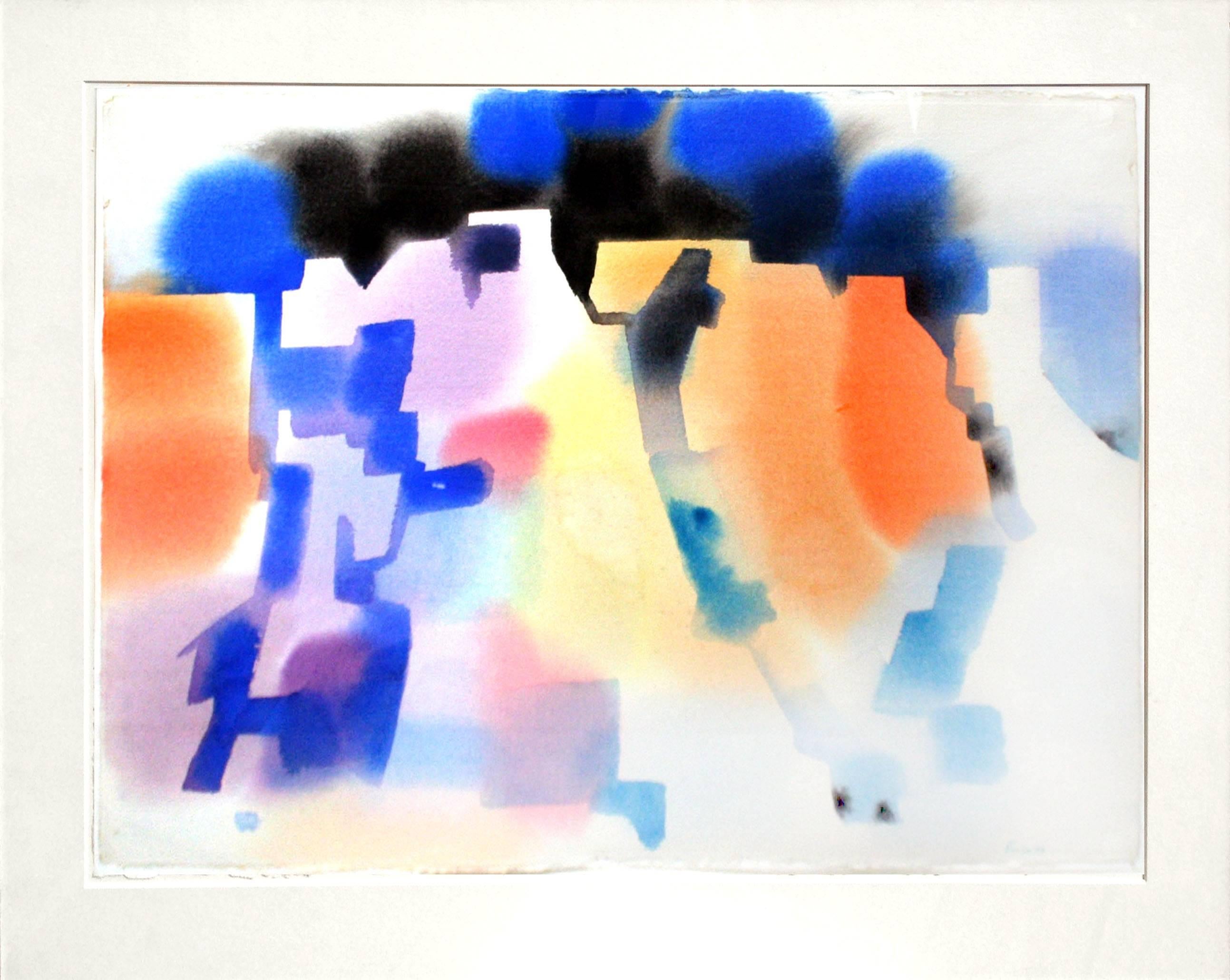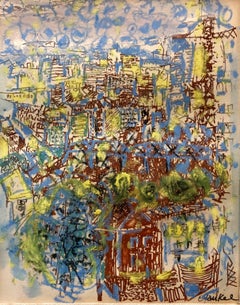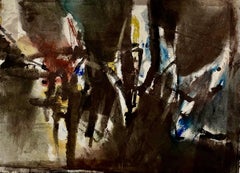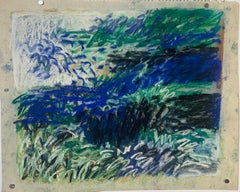
Abstract Expressionist Paris Landscape Painting
View Similar Items
Want more images or videos?
Request additional images or videos from the seller
1 of 8
Jacques YankelAbstract Expressionist Paris Landscape Painting
About the Item
- Creator:Jacques Yankel (1920, French)
- Dimensions:Height: 19.5 in (49.53 cm)Width: 17.25 in (43.82 cm)
- Medium:
- Movement & Style:
- Period:
- Condition:minor wear to frame and mat.
- Gallery Location:Surfside, FL
- Reference Number:1stDibs: LU3822608721
About the Seller
4.9
Platinum Seller
These expertly vetted sellers are 1stDibs' most experienced sellers and are rated highest by our customers.
Established in 1995
1stDibs seller since 2014
1,546 sales on 1stDibs
Typical response time: 1 hour
More From This SellerView All
- Abstract Expressionist Paris Landscape PaintingBy Jacques YankelLocated in Surfside, FLJacques Yankel, pseudonym of Jakob Kikoine, born on April 14 , 1920 in Paris, is a French painter and sculptor. He is the son of the painter Michel Kikoine. Born in Boucicaut hospital, Jacques lived as a child in the artists' colony La Ruche in Paris. He grew up to the age of ten at La Ruche, the workshop created for artists by the sculptor Alfred Boucher, in the 15th arrondissement of Paris. Around him live also other artists, including the inseparable Pincus Krémègne and Chaïm Soutine, arrived from Vilnius in Russia where they met. It is an extraordinary intellectual and artistic universe where the genius of the artists and their great poverty rub shoulders in a Paris which hosts this Expressionist school which will become "the School of Paris". Chagall, Modigliani, Fernand Léger, Alexander Archipenko, Max Jacob and others. When he had just started studying at the École des Arts Appliqués in Paris, he was forced to flee to Southern France with his family to escape the Nazis. During the Second World War, he held temporary jobs in printing and engraving workshops, notably at the Draeger printing press in Toulouse, where events led him to take refuge with his family. From 1940 to 1945, he pursued very advanced studies of geology at the Faculty of Sciences, specializing in micro-geology. He graduated in 1943. In 1947, he participates episodically as an amateur painter in the Chariot group, with the artists Jean Hugon, Michel Goedgebuer, Robert Pagès, Christian Schmidt, Andre-Francois Vernette, Jean Teulieres. The group is active until 1954. In 1949, he was hired by the Colonial Office for the geological map of Gao - Timbuktu - Tabankort in French West Africa . From this episode, he will keep a certain taste for African art of which he will become a collector. The following year, he unexpectedly met Simone de Beauvoir and Jean-Paul Sartre in Gao. The latter encourages him to return to painting. He won the Neuman First Prize, which he shared with Reginald Pollack and a Fénéon Prize Scholarship. Among his friends are Clavé, Cottavoz, Pelayo, Hanna Ben-dov, Pollack, Jean Jansem, Roger Lersey. In 1953, accompanied by Orlando...Category
Mid-20th Century Abstract Expressionist Abstract Drawings and Watercolors
MaterialsPaper, Oil Pastel
- Modernist Abstract Expressionist Watercolor Painting Bauhaus Weimar Pawel KontnyBy Pawel KontnyLocated in Surfside, FLAbstract watercolor composition bearing the influence of the earlier color-block compositions of Paul Klee. Pawel August Kontny, (Polish-German-American artist) He was born in Laurahuette, Poland, in 1923, the son of a wealthy pastry shop owner. In 1939 he began studying architecture in Breslau where he was introduced to the European masters and to the work of some of the German Expressionists, soon afterward banned as "degenerate artists" and removed from museums throughout Germany by the Nazi regime. His studies were interrupted by World War II. Drafted into the German army, traveling in many countries as a soldier, he sketched various landscapes but in 1945, he was captured and held as a prisoner of war in Italy. After the war, he studied at the Union of Nuremberg Architects to help design buildings to replace ones destroyed in the war. He recorded his impressions of the local population and the landscapes through his watercolors and drawings. Pawel Kontny thereafter moved to Nuremberg, Germany, becoming a member of the Union of Nuremberg Architects and helping to rebuild the city's historic center. He soon decided to concentrate on his professional art career. He married Irmgard Laurer, a dancer with the Nuremberg Opera. Pavel Kontny 's career as an artist was launched with his participation in an all German exhibition, held at the Dusseldorf Museum in 1952. He held one-man shows in Germany, Switzerland and the United States. During his trip to the United States in 1960, Kontny became instantly enamored with Colorado, and decided to relocate to Cherry Hills with his wife and two children. He quickly established himself in the local art community, being affiliated for a time with Denver Art Galleries and Saks Galleries. His subject matter became the Southwest. During this time he received the Prestigious Gold Medal of the Art Academy of Rome. His extensive travel provided material for the paintings he did using his hallmark marble dust technique. he also worked equally in pastel, watercolor, charcoal and pencil-and-ink. in a style which merged abstraction and realist styles, influenced by Abstract Expressionist painting and South Western American landscapes. This one bears the influence of Sam Francis. In the early 1960s he was one of only a few European-born professional artists in the state, a select group that included Herbert Bayer (1900-1985), a member of the prewar Bauhaus in Weimar and Dessau, Germany, and Roland Detre (1903-2001), a Hungarian modernist painter. As a Denver, Colorado resident, Pavel Kontny exhibited at galleries and museums throughout the United States, Germany and Japan. There, he was inspired by frequent trips to Native American pueblos in the Southwest, as well as by the study of the Plains Indians of Montana and Wyoming. Over the years Kontny had a number of students and generously helped young artist by hosting exhibitions at his Cherry Hills home. For many years he generously donated his paintings to support charitable causes in Denver. Influences during his European years included German pastelist C.O. Muller, German Informel painter Karl Dahmen and Swiss artist, Hans Erni. In the early 1950s his painting style showed the influence of the Die Brücke (The Bridge), a group of German expressionist artists formed in Dresden in 1905 who had a major impact on the evolution of modern art in the twentieth century in Germany. By the middle of the decade his style incorporated more referential abstraction and total abstraction, resulting in part from his study of Hans Hartung, a German artist based in Paris who exhibited his gestural abstract work in Germany. The American moon landing in 1969 inspired Paul Kontny...Category
20th Century American Modern Abstract Drawings and Watercolors
MaterialsWatercolor, Archival Paper
- Modernist Abstract Expressionist Watercolor Painting Bauhaus Weimar Pawel KontnyBy Pawel KontnyLocated in Surfside, FLAbstract watercolor composition bearing the influence of the earlier color-block compositions of Paul Klee. Pawel August Kontny, (Polish-German-American artist) He was born in Laurahuette, Poland, in 1923, the son of a wealthy pastry shop owner. In 1939 he began studying architecture in Breslau where he was introduced to the European masters and to the work of some of the German Expressionists, soon afterward banned as "degenerate artists" and removed from museums throughout Germany by the Nazi regime. His studies were interrupted by World War II. Drafted into the German army, traveling in many countries as a soldier, he sketched various landscapes but in 1945, he was captured and held as a prisoner of war in Italy. After the war, he studied at the Union of Nuremberg Architects to help design buildings to replace ones destroyed in the war. He recorded his impressions of the local population and the landscapes through his watercolors and drawings. Pawel Kontny thereafter moved to Nuremberg, Germany, becoming a member of the Union of Nuremberg Architects and helping to rebuild the city's historic center. He soon decided to concentrate on his professional art career. He married Irmgard Laurer, a dancer with the Nuremberg Opera. Pavel Kontny 's career as an artist was launched with his participation in an all German exhibition, held at the Dusseldorf Museum in 1952. He held one-man shows in Germany, Switzerland and the United States. During his trip to the United States in 1960, Kontny became instantly enamored with Colorado, and decided to relocate to Cherry Hills with his wife and two children. He quickly established himself in the local art community, being affiliated for a time with Denver Art Galleries and Saks Galleries. His subject matter became the Southwest. During this time he received the Prestigious Gold Medal of the Art Academy of Rome. His extensive travel provided material for the paintings he did using his hallmark marble dust technique. he also worked equally in pastel, watercolor, charcoal and pencil-and-ink. in a style which merged abstraction and realist styles, influenced by Abstract Expressionist painting and South Western American landscapes. This one bears the influence of Sam Francis. In the early 1960s he was one of only a few European-born professional artists in the state, a select group that included Herbert Bayer (1900-1985), a member of the prewar Bauhaus in Weimar and Dessau, Germany, and Roland Detre (1903-2001), a Hungarian modernist painter. As a Denver, Colorado resident, Pavel Kontny exhibited at galleries and museums throughout the United States, Germany and Japan. There, he was inspired by frequent trips to Native American pueblos in the Southwest, as well as by the study of the Plains Indians of Montana and Wyoming. Over the years Kontny had a number of students and generously helped young artist by hosting exhibitions at his Cherry Hills home. For many years he generously donated his paintings to support charitable causes in Denver. Influences during his European years included German pastelist C.O. Muller, German Informel painter Karl Dahmen and Swiss artist, Hans Erni. In the early 1950s his painting style showed the influence of the Die Brücke (The Bridge), a group of German expressionist artists formed in Dresden in 1905 who had a major impact on the evolution of modern art in the twentieth century in Germany. By the middle of the decade his style incorporated more referential abstraction and total abstraction, resulting in part from his study of Hans Hartung, a German artist based in Paris who exhibited his gestural abstract work in Germany. The American moon landing in 1969 inspired Paul Kontny...Category
20th Century American Modern Abstract Drawings and Watercolors
MaterialsWatercolor, Archival Paper
- Modernist Abstract Expressionist Watercolor Painting Bauhaus Weimar Pawel KontnyBy Pawel KontnyLocated in Surfside, FLAbstract watercolor composition bearing the influence of the earlier color-block compositions of Paul Klee. Pawel August Kontny, (Polish-German-American artist) He was born in Laurahuette, Poland, in 1923, the son of a wealthy pastry shop owner. In 1939 he began studying architecture in Breslau where he was introduced to the European masters and to the work of some of the German Expressionists, soon afterward banned as "degenerate artists" and removed from museums throughout Germany by the Nazi regime. His studies were interrupted by World War II. Drafted into the German army, traveling in many countries as a soldier, he sketched various landscapes but in 1945, he was captured and held as a prisoner of war in Italy. After the war, he studied at the Union of Nuremberg Architects to help design buildings to replace ones destroyed in the war. He recorded his impressions of the local population and the landscapes through his watercolors and drawings. Pawel Kontny thereafter moved to Nuremberg, Germany, becoming a member of the Union of Nuremberg Architects and helping to rebuild the city's historic center. He soon decided to concentrate on his professional art career. He married Irmgard Laurer, a dancer with the Nuremberg Opera. Pavel Kontny 's career as an artist was launched with his participation in an all German exhibition, held at the Dusseldorf Museum in 1952. He held one-man shows in Germany, Switzerland and the United States. During his trip to the United States in 1960, Kontny became instantly enamored with Colorado, and decided to relocate to Cherry Hills with his wife and two children. He quickly established himself in the local art community, being affiliated for a time with Denver Art Galleries and Saks Galleries. His subject matter became the Southwest. During this time he received the Prestigious Gold Medal of the Art Academy of Rome. His extensive travel provided material for the paintings he did using his hallmark marble dust technique. he also worked equally in pastel, watercolor, charcoal and pencil-and-ink. in a style which merged abstraction and realist styles, influenced by Abstract Expressionist painting and South Western American landscapes. This one bears the influence of Sam Francis. In the early 1960s he was one of only a few European-born professional artists in the state, a select group that included Herbert Bayer (1900-1985), a member of the prewar Bauhaus in Weimar and Dessau, Germany, and Roland Detre (1903-2001), a Hungarian modernist painter. As a Denver, Colorado resident, Pavel Kontny exhibited at galleries and museums throughout the United States, Germany and Japan. There, he was inspired by frequent trips to Native American pueblos in the Southwest, as well as by the study of the Plains Indians of Montana and Wyoming. Over the years Kontny had a number of students and generously helped young artist by hosting exhibitions at his Cherry Hills home. For many years he generously donated his paintings to support charitable causes in Denver. Influences during his European years included German pastelist C.O. Muller, German Informel painter Karl Dahmen and Swiss artist, Hans Erni. In the early 1950s his painting style showed the influence of the Die Brücke (The Bridge), a group of German expressionist artists formed in Dresden in 1905 who had a major impact on the evolution of modern art in the twentieth century in Germany. By the middle of the decade his style incorporated more referential abstraction and total abstraction, resulting in part from his study of Hans Hartung, a German artist based in Paris who exhibited his gestural abstract work in Germany. The American moon landing in 1969 inspired Paul Kontny...Category
20th Century American Modern Abstract Drawings and Watercolors
MaterialsWatercolor, Archival Paper
- Large Colorful Modernist Pastel Abstract Expressionist Painting Sylvia CareweLocated in Surfside, FLFramed 33 X 45.5 image is 29 X 41.5 Hand signed lower left Signed and titled verso Sylvia Carewe (1906-1981) was an American woman artist, painter, writer and poet. Born in New York City to Russian immigrant parents, Louis and Esther Kerewsky, she changed her surname to "Carewe" in 1930. Carewe attended Columbia University and studied further with Yasuo Kuniyoshi at Atelier 17 in New York, with Hans Hoffman in New York and Provincetown, Massachusetts, and at the New School for Social Research. During World War II Carewe worked as an advertising copywriter and artist for agencies in New York. She became a prolific abstract artist in a range of media, including tapestry designs for the Aubusson tapestry carpet company in France, felt banners, collage reliefs, and what she termed "blown paintings," which were assemblages (predominantly of children's toy components) overlaid with spray paint. One of the most common subjects in her semi abstract paintings was New York City at night. She also worked in traditional artistic media, including watercolors, oils, lithographs and pastels. In October 1944, she married Marvin Small (formerly Smalheiser, executive for Carter's Little Liver Pills). They had one child, John Marvin, in June 1947. Carewe had her first one-woman show in Poughkeepsie in 1947, after which she opened in New York City at the ACA Gallery in 1948. She had some twenty other American solo shows and her works hung in many exhibits across the United States as well as in France, Belgium and the Netherlands. Her works are represented in the permanent collections of the Whitney Museum, Musée de l'Arte Moderne, Paris, Brandeis University, the Butler Art Institute, Howard University, the Tel Aviv Museum and the National Museum in Djakarta, Indonesia. Her work has been described by French critics as "violent, colorful art, in hard contrasts, not exempt from cold lyricism." ["Les Girls...Category
Mid-20th Century Abstract Expressionist Abstract Paintings
MaterialsOil Pastel, Paper
- Abstract Expressionist Gestural Oil Pastel Drawing Women Figures Anthony TrianoLocated in Surfside, FLAnthony Thomas Triano (1928–1997) was an abstract expressionist painter, sculptor, illustrator and teacher. His works feature natural forms, especially the human form, and tend towar...Category
1960s Abstract Expressionist Abstract Drawings and Watercolors
MaterialsPaper, Oil Pastel
You May Also Like
- Light Buttress, by Kenneth Draper, pastel, paper, framed, abstract, EnglandBy Kenneth DraperLocated in Santa Fe, NMframe size 27.5" x 25.5" Light Buttress, by Kenneth Draper, pastel, paper, framed, abstract, EnglandCategory
21st Century and Contemporary Abstract Expressionist Abstract Drawings a...
MaterialsOil Pastel
- Llangorse Lake, Brecon Beacons, Wales, circa 1964. Welsh Landscape. Abstract.By Roger CecilLocated in Sutton Poyntz, DorsetRoger Cecil. Welsh ( b.1942 - d.2015 ). Llangorse, Brecon Beacons Watercolor and pastel on paper. Signed. Image size 19.5 inches x 29.5 inches ( 49.5cm x 75cm ). Frame size 24.6 inches x 34.6 inches ( 62.5cm x 88cm ). Available for sale; this original painting is by the Welsh artist Roger Cecil and dates from around 1964. The watercolor and pastel work is presented and supplied in a sympathetic contemporary frame (our stock frame, which is shown in these photographs), mounted using conservation materials and behind glass. The original backboard has been reused but the artwork has been isolated from it using conservation barrier materials. This vintage artwork is in good condition, commensurate with its age. Previous cockling (rippling) of the paper has been eliminated by stretching and the use of a new mounting. Previous foxing and age marks have been mechanically removed and the coarse fiber of the paper has been made good in these areas. The painting is now ready to hang and display. The watercolor is signed lower left. Provenance: Previously with the Howard Roberts Gallery, Imperial Buildings, 69/74 St Mary Street, Cardiff. Roger Cecil was a reclusive painter, draughtsman and teacher who was born in Abertillery, Monmouthshire in 1942. He lived and worked in Wales for the last four decades of his life, much of it in the house where he was born and brought up. Cecil produced abstract work rich in imagery, poetry and color, which were drawn from his environment, the industrial valley towns and mountains. Prolific and obsessive, he was always a solitary artist, with no affiliations to any group or artistic movement. He worked for more than forty years, with an ever evolving and prolific creative output. His pictures capture the geology and the history of the places he knew so intimately, and the impact of man of that environment. Cecil studied Fine Art at Newport College of Art from 1959 to 1963, where his teachers included John Wright and Thomas Rathmell; in 1963 he gained the College’s highest award in the national diploma in design and a place at the Royal College London. In 1964 he won the David Murray Landscape Award from the RA. He took up his place at the Royal College of Art, but after just a few weeks he was unsatisfied and instead took up manual work in opencast mines and building sites. Cecil later spent some time teaching at Ebbw Vale. From 1995 to 1998 he did his MA, which he gained with distinction in communication design at St. Martin’s College of Art. The BBC made a television documentary on Cecil's work called The Gentle Rebel. For a long time Cecil did not exhibit, through choice, and it was friends who helped to promote him. He then had a series of exhibitions at Business Art Galleries from 1987, and in 1995 the Hill Court Gallery, Abergavenny, held a retrospective of his work. In 1998 Gordon Hepworth and Y Tabernacl both showed Cecil's pictures. Cecil’s works were also shown at the Oriel Myrddin Gallery in 2006 and 20011. The small book which takes the name of the earlier exhibition ”Cariad”; has an introduction by gallery manager Meg Anthony which states; “The magic of Roger Cecil’s work is in part down to the man, for he is enigmatic and surprising, diffident and proud. He has deliberately avoided the art establishment, remaining shy of its protocol and systems of exposure and recognition. He has consciously created the space to pursue his art, away from the pressures of publicity and celebrity...... paint is Roger’s passion.” Cecil’s methods were complex; he worked with a mixture of materials, including oil pastels, sandpaper, primer and plaster. He built up layers and then he rubbed and scratched them away. His work is textured and nuanced, and the color reverberates as if it has a life of its own. The paintings are abstract, but there are echoes of monumental shapes and undulations of the female form, the Valleys - the dark hills embracing the bowls of space and the rich, gritty textures of the industrial and post-industrial landscape, highlighted by intricate, personal marks. Sarah Bradford states: “Scale is an important feature of Roger Cecil’s work; he constantly shifts from near and the far off. He also moves his viewpoint from looking at, to looking down on to. This looking down, as though a bird, onto the world of the painting, comes from exploration of his surroundings and from the ordinance survey maps he takes with him when he walks. He has often said how he is inspired by the language of symbols and lines that are used in maps to delineate the landscape. It is easy to see the connection when looking at the networks of invented footpaths, waterways, and other pinpoint features that can be found in his work.” … Mary Lloyd...Category
Mid-20th Century Abstract Expressionist Landscape Drawings and Watercolors
MaterialsPaper, Pastel, Watercolor
- "Pastel Landscape in Blues 2" Original Impressionist Landscape DrawingBy Edith Isaac-RoseLocated in Arp, TXEdith Isaac-Rose "Pastel Landscape in Blues 2" c.1960 Pastel on paper 17"x15" unframed Unsigned Edith Isaac-Rose (1929-2018) Born in Chicago in 1929, and neé Ganansky-Teitelbaum, she graduated from The Art Institute of Chicago in 1951 and moved to New York in 1959 where she lived ever since. Taking as her professional name her parents’ first names, Edith was a prolific artist working first as an abstract expressionist then turning in the 1980s to figurative, political work consisting of drawings, paintings, and embroideries which she called “Daily Rage”. She had been represented by the Phyllis Kind Gallery and her work is in the Hirshhorn Museum as well as numerous private collections. Edith, along with her partner of 35 years, Bea Kreloff, (1925-2016), founded Art Workshop International in 1981 where they held art and writing workshops in Assisi, Italy, Monhegan Island, Maine, and Puerto Escondido, Mexico. Edith was a resident at the Westbeth Artist Housing in Greenwich Village and was actively involved with the anti-war movement, gay liberation...Category
Mid-20th Century Abstract Impressionist Landscape Drawings and Watercolors
MaterialsPaper, Oil Pastel
- 1988 "Sacred Night" Abstract Landscape DrawingBy Elaine Kaufman FeinerLocated in Arp, TXElaine Kaufman Feiner (1922-2018) "Sacred Night" 1993 Oil pastel on paper 30"x40" unframed Signed and dated in pencil lower right, signed, titled and dated on reverseCategory
1980s Abstract Abstract Drawings and Watercolors
MaterialsPaper, Oil Pastel
- 1988 "Hawaii II" Abstract Landscape DrawingBy Elaine Kaufman FeinerLocated in Arp, TXElaine Kaufman Feiner (1922-2018) "Hawaii II" 1993 Oil pastel, paint on paper 30"x40" unframed Signed and dated in pencil lower right, signed, titled and dated on reverseCategory
1980s Abstract Abstract Drawings and Watercolors
MaterialsPaint, Paper, Oil Pastel
- The Cliff, Abstract Colorado Landscape, American Modernist Pastel DrawingBy Eric BransbyLocated in Denver, COAbstract Colorado mountain landscape by Eric James Bransby (1916-2020). Pastel on paper in colors of green, orange, blue, and purple. Presented in a custom frame with archival materi...Category
1990s Abstract Abstract Drawings and Watercolors
MaterialsOil Pastel, Pastel, Archival Paper
$3,800 Sale Price20% Off
Recently Viewed
View AllMore Ways To Browse
School Of Paris
Paris Landscape
Paris Landscape Painting
Paris Fine Arts
Vintage World Paris
Paris 1960 Painting
Expressionist Paris
Paris 1947
1950s Paris Painting
Ecole De Paris Painting
April In Paris
Abstract Architectural Drawings
50s Painting
50s Paintings
Mid Century Abstract Expressionism
Midcentury Abstract Expressionism
Abstract Expressionist 1950s
1950s Abstract Expressionist Painting
